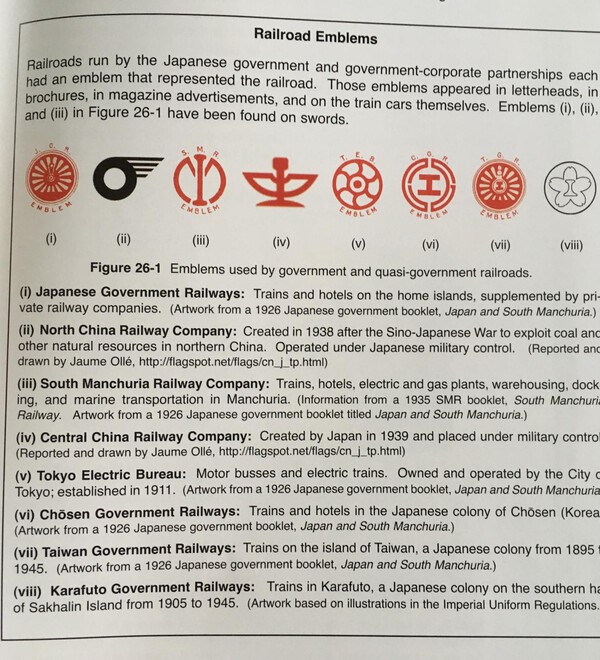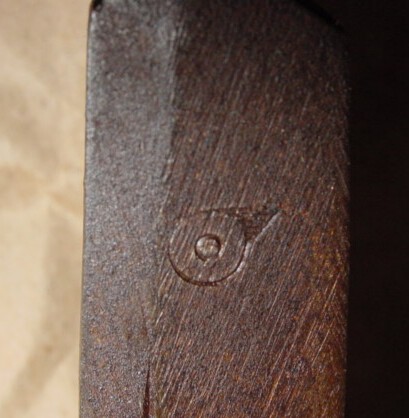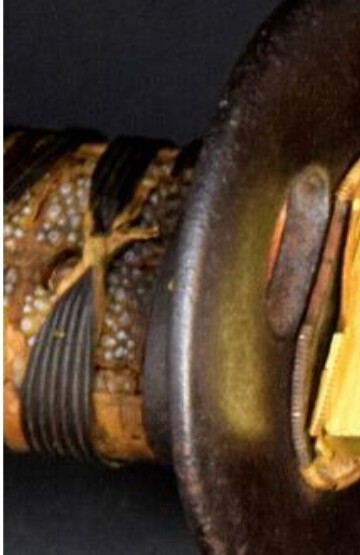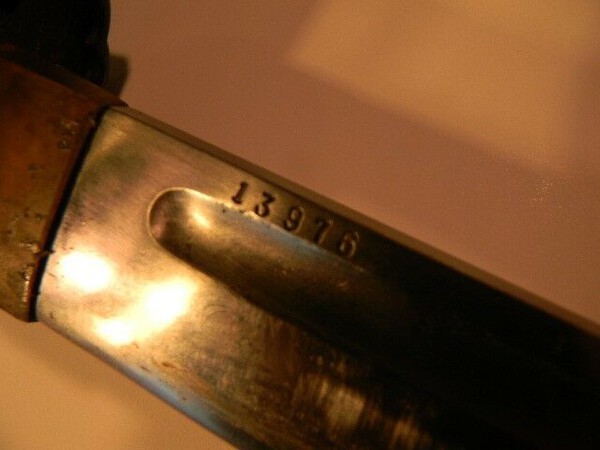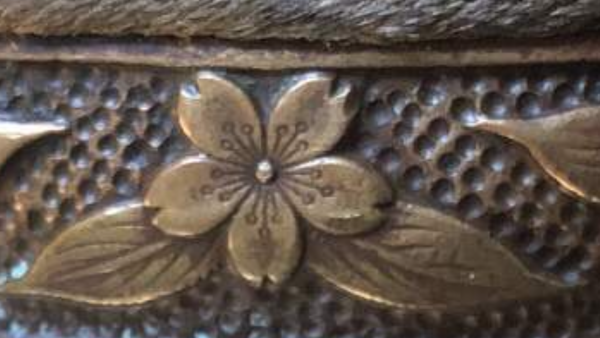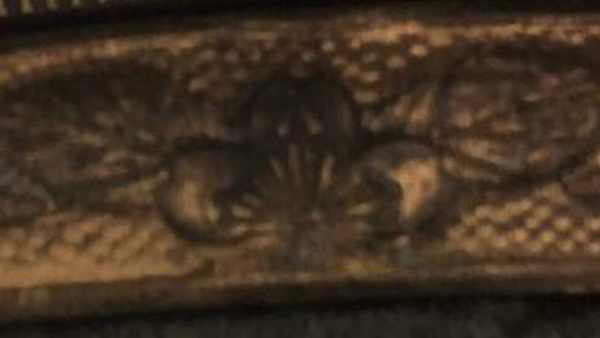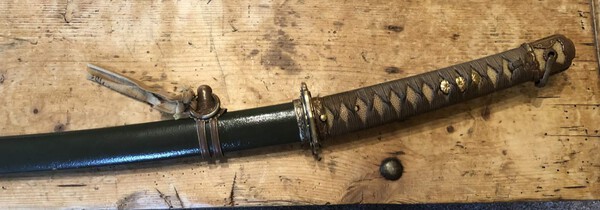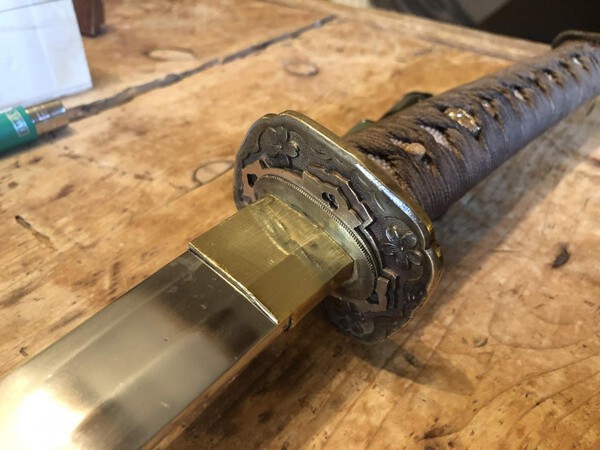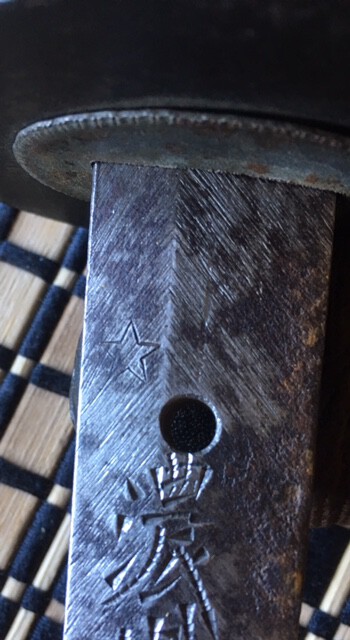-
Posts
13,744 -
Joined
-
Last visited
-
Days Won
168
Content Type
Profiles
Forums
Events
Store
Downloads
Gallery
Everything posted by Bruce Pennington
-
Sterlin, Check out this thread on the Sharpening and Dulling of blades from Nick Komiya at Warrelics: http://www.warrelics.eu/forum/Japanese-militaria/sharpening-dulling-blades-were-taken-granted-675938/ I can't say for sure that your blade was dulled for this reason, but it is a possibility.
-
Neil! I just shake my head and laugh out of astonishment. Where do you get these things!?!?!
-

Railway Swords & Stamps
Bruce Pennington replied to Bruce Pennington's topic in Military Swords of Japan
Stegel, fabulous examples! And I did not have that serial number on of that second one. Too bad you don't have it for that first one! Yeah, I don't know what to think about that purple ito. They DID have some purple wraps back then, but this one just looks too new. The last one with the South China railway is the second I've seen now, outside of Dawson's one, and it looks like they are all non-Mantetsu. Dawson stated that the SCR commissioned the blades, so they must have been made by other smiths. -
Dan, That's unique! And I have not seen that before. Shamsy probably has, though you might PM him to check.
-

Samurai Katana - fake or real?
Bruce Pennington replied to Anna-wve's topic in Military Swords of Japan
Anna, the Damascus steel is a dead giveaway. Plus the kanji are junk. There are a lot of these showing up lately. Amazingly, they were being produced right after the war to make a killing offf the vast numbers of G.i.s during the occupation. -

Attention Mantetsu Owners: A Survey
Bruce Pennington replied to Bruce Pennington's topic in Military Swords of Japan
Thanks Jean-Pierre, I also have that. I posted it on the Battle Damage thread as well: http://www.militaria.co.za/nmb/topic/23378-any-shin-gunto-with-battle-scars/page-2?hl=+battle%20+damage I’ve pent a few days scouring the web for these. About the only ones I won’t have is something newly posted somewhere. -
That’s a beauty Dan! The Tokyo star should put the manufacture date at or after late ‘40, early ‘41. Stengel or Shamsy might be able to narrow that based on serial number.
-

Railway Swords & Stamps
Bruce Pennington replied to Bruce Pennington's topic in Military Swords of Japan
Wow Trystan, completely new to me, and not on Dawson’s chart. Thanks for that one! -
This may be a slow thread to start as these gunto are pretty rare, but I thought I'd toss it out there: Dawson lists 8 emblems but states he knows of only the first 3 found on gunto - Japanese Govt Railways, South China Railway Co, and the SMR. I'm posting the chart along with a SCR emblem found on fleabay 9 years ago (link is already dead). Anyone have real examples? (I know we have lots of the SMR emblem. I'm really looking for all the others)
-

Nakago mei translation please - Blade opinion?
Bruce Pennington replied to acoyauh's topic in Translation Assistance
-
Good example Stegel! I've seen a few of these over the past couple of years with that same serial number, or range. I was thinking the faker was making multiple blades with the same number, but after reading your post, I see I might have just seen the same fake 2 or 3 times as it changed hands.
-

Shin-Gunto Research , what do i have?
Bruce Pennington replied to Scott M's topic in Military Swords of Japan
Wow, Scott, that came out perfectly! Looks original. Nice job! -

Type 44 Katana + Information request
Bruce Pennington replied to IbexiSterlinfa's topic in Translation Assistance
The “Z” appears to simply be bare metal where the tsuka rubs, wearing off rust. The stamp is more likely to be where I’ve circled. The tsuba stamp is “Gifu” which was a province where Seki was located. While required by law, stamping wasn’t practiced 100% of the time, and while rare, the stamps were sometimes removed. -

Gunto Tsuba dug up in Russia?
Bruce Pennington replied to Logan09's topic in Military Swords of Japan
Logan, I checked the item description. He didn’t say it was found on a battlefield, he just said it was found with a metal detector. It was simply something brought back from the war and got dumped on the ground or discarded for some reason. -

Gunto Tsuba dug up in Russia?
Bruce Pennington replied to Logan09's topic in Military Swords of Japan
Tsuba looks legit, a bit corroded from being buried in dirt. The Russians invaded Manchuria and made it all the way to Korea, including taking Mukden, where there was an arsenal (thought to be making Mantetsu blades, or at least finishing them). So there were plenty of Japanese swords that were carried home by Russian soldiers. This tsuba was no doubt part of their war souvenirs brought home. -

Attention Mantetsu Owners: A Survey
Bruce Pennington replied to Bruce Pennington's topic in Military Swords of Japan
Thanks JP, I appreciate it! But it is one I have already. -

What the heck? Koiguchi
Bruce Pennington replied to Bruce Pennington's topic in Military Swords of Japan
Nick Komiya says it’s a cherry blossom. I can see it now, but it’s crafted in a way I’ve never seen. -
This koiguchi is on a mumei gunto being discussed on Warrelics http://www.warrelics.eu/forum/Japanese-militaria/katana-inscription-cloth-help-730056-2/#post1957514 Any ideas what this is on the koiguchi where the cherry blossom should be? The blade is nothing special, an unsigned WWII factory blade, and fittings normal except for this and an extra thin tsuba. Ideas?
-

Attention Mantetsu Owners: A Survey
Bruce Pennington replied to Bruce Pennington's topic in Military Swords of Japan
Thanks, great one! It's my first and only "No" serial number! And yes, the nakago looks quite worn! I don't see how a nakago could get so worn under a tsuka. I almost want to think it was previously heavily rusted and has been cleaned, but "cleaned" would look shiny and buffed, where this still looks old and just worn. Interesting one. -

New sword variant discovered?
Bruce Pennington replied to IJASWORDS's topic in Military Swords of Japan
Neil, my feelings exactly! Just look at the NCO production for 1945 - they went from an average of 2,500 guntos/month to Jan 45 - 5,000 and Aug '45 - 10,000! This was the final year of the war when materiel shortages would have been at their highest level, yet the Govt was demanding that production be increased due to their fear of a looming Allied home invasion. They must have been scrambling to get their hands on any piece of koshirae they could find. As a side note: My early feeling that the mysterious NLF gunto (mixed navy and army) was late-war pieced together parts - falls apart in light of your collection. Your 3 are how things would look when peicing things together in desperation. The "NLF" gunto were to precisely uniform and really good looking. It's clear in comparison that they were newly produced for souvenirs. -

Attention Mantetsu Owners: A Survey
Bruce Pennington replied to Bruce Pennington's topic in Military Swords of Japan
I'm firmly on the fence (though wavering to fake). The mei and serial numbers are as good as any Mantetsu out there. New- I first thought "well, the polisher would have cleaned the whole thing, that's why it looks new." I checked my polished Mantetsu, and while he shined the nakago, there is patina still imbeded in the kanji cuts. Soooo, either the one in question was cut recently, and no patina, or the polisher REALLY cleaned the nakago - UNKNOWN. We have a sample of 2 (maybe 3), but both the current ones looks identical and too new. I'm saving this one like I did the last one - "under suspicion". I would love to see (assuming fakery) one come out with an identical serial number to an existing one in the database. But, there were approx. 38,000 of these made, with a database of 160, so the odds are in their favor right now. -

Type 44 Katana + Information request
Bruce Pennington replied to IbexiSterlinfa's topic in Translation Assistance
Ibex, How about going to the settings section and inputing a first name so we can really chat with a person. Not being trite, it's forum rules, and we really do like to talk to real people! Here's a great read on the Rinji/Contengency Model/Type 3/'44 Model from Nick Komiya: http://www.warrelics.eu/forum/Japanese-militaria/legally-rebutting-existence-type-3-army-officers-sword-708745/ Does your rig have the double release button or just a single? Would love to see a picture of the fittings. Yours doesn't appear to have the star at first glance. Recommend taking everything off including the habaki. Sometimes stamps hide up higher on the nakago (tang). Here's a picture of my star stamp. You may also have small stamps on the back edge (mune) of the nakago. -

Attention Mantetsu Owners: A Survey
Bruce Pennington replied to Bruce Pennington's topic in Military Swords of Japan
Thanks Brandon. I just learned that on a similar discussion on the Translation Assistance thread. They said these "signature" marks by the polisher have been used for centuries. I'm not a nihonto collector, so I haven't come across them before (or noticed them if I did). I guess the problem is the same, though. Even if the polisher was a current one from today, not WWII, it doesn't prove or disprove, by itself, the age or legitimacy of the blade. If the marks are unique to a particular polisher, I think it adds some building evidence that a particular seller in Japan is turning mumei blades into Mantetsu blades and having them polished by his favorite polisher. They all have the same look, polish, and attribution characteristics. -

Col Nakagawa, Peleliu Inscription?
Bruce Pennington replied to Bruce Pennington's topic in Translation Assistance
Thanks Logan. So, even if the polisher is modern, that fact alone doesn't mean the blade is new, so hrumph. -

Col Nakagawa, Peleliu Inscription?
Bruce Pennington replied to Bruce Pennington's topic in Translation Assistance
Logan, is that what those parallel lines are that my arrow is pointing to? The polisher puts that there? Is that a modern polisher practice? I don't recall seeing those on WWII era blades.



